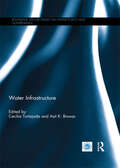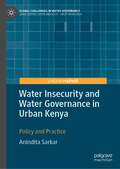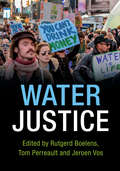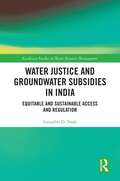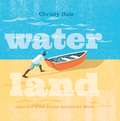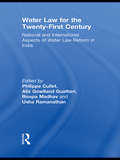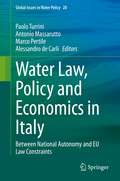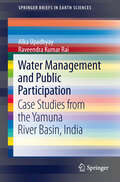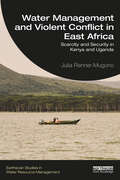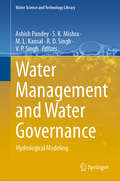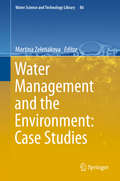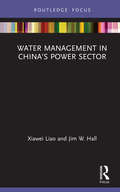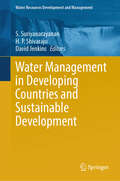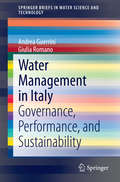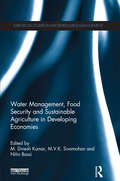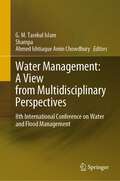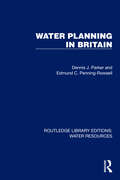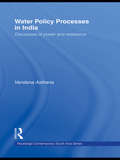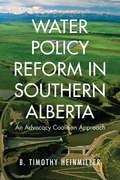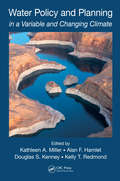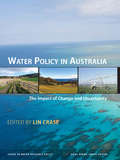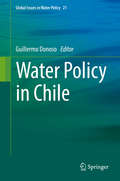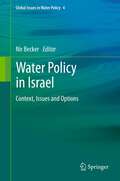- Table View
- List View
Water Infrastructure (Routledge Special Issues on Water Policy and Governance)
by Cecilia Tortajada and Asit K. BiswasWater infrastructure is an essential element in water management. Together with institutions, policies and regulation, it provides basic services to growing populations, especially in developing countries, where much of the growth is taking place. In the Asia-Pacific region, for instance, populations are growing not only in size but also in affluence, straining further the existing infrastructure and demanding urgently the development of a new one. While 79% of total water use in Asia occurs in agriculture, the fastest increases in demand are emanating from industry and from urban areas. This trend is a natural consequence of the fastest industrialization and urbanization process in history. By 2030, more than 55% of Asia’s population will live in urban areas, an increase of 1.1 billion people. Nevertheless, water infrastructure is of concern not only in the global South but also in the North, where much of the drinking-water infrastructure needs upgrading or replacement, a significant undertaking as infrastructure is more than a hundred years old in many cases. The American Water Works Association estimates that changing all of the water pipes in the United States would cost more than USD 1 trillion. In this book, in-depth case studies on water infrastructure challenges and policy solutions are presented from different parts of the world.This book was published as a special issue of the International Journal of Water Resources Development.
Water Insecurity and Water Governance in Urban Kenya: Policy and Practice (Global Challenges in Water Governance)
by Anindita SarkarThis book explores water service provisions of the urban poor in the cities of Africa with particular emphasis on Kenya and its capital city of Nairobi. In particular the book addresses the insecurity of tenure, and how the colonial segregation of land continues to shape water access and service provision even today in Nairobi. The book seeks to understand how urban water management entails the “production of thirst” among the urban poor and documents how cultural norms, political commitments and seemingly mundane practices of water managers combine to exclude the poor from accessing water. Supporters of privatization argue that private companies may succeed where governments have failed in supplying water to the urban poor. The author takes a closer look at this argument, demonstrating the limitations of some of the current reforms whilst also exploring alternatives and solutions. This book will be an invaluable reference for students, researchers and practitioners working in this field.
Water Justice
by Rutgerd Boelens Tom Perreault Jeroen VosWater justice is becoming an ever-more pressing issue in times of increasing water-based inequalities and discrimination. Megacities, mining, forestry, industry and agribusiness claim an increasingly large share of available surface and groundwater reserves. Water grabbing and pollution generate poverty and endanger ecosystems' sustainability. Beyond large, visible injustices, the book also unfolds the many 'hidden' water world injustices, subtly masked as 'rational', 'equitable' and 'democratic'. It features critical conceptual approaches, including analysis of environmental, social, cultural and legal issues surrounding the distribution and management of water. Illustrated with case studies of historic and contemporary water injustices and contestations around the world, the book lays new ground for challenging current water governance forms and unequal power structures. It also provides inspiration for building alternative water realities. With contributions from renowned scholars, this is an indispensable book for students, researchers and policymakers interested in water governance, environmental policy and law, and political geography.
Water Justice and Groundwater Subsidies in India: Equitable and Sustainable Access and Regulation (Earthscan Studies in Water Resource Management)
by Gayathri D. NaikThis book examines the impact of water-related subsidies on social and distributive equity and environmental sustainability in groundwater access and regulation in India.This book argues that adopting a water justice framework is essential to ensure equitable and sustainable access to and regulation of groundwater by balancing anthropogenic and ecological water needs. The inherent inequity resulting from property rights-controlled groundwater access gets widened by the social, political, and economic factors determining the subsidy beneficiaries. Adopting a socio-legal approach, this book draws on two contrasting case studies in India: Kerala, a water-secure state, and Rajasthan, an arid state. Arguing for a shift to a new paradigm in water governance, it critically examines the feasibility of the public trust doctrine and rights of nature discourse to analyse the best suitable regulatory framework that can balance the human right to water and ecological sustainability in groundwater resources. It demonstrates the feasibility of adopting various environmental law principles that balance human rights to water and nature. It argues that the hitherto highlighted public trust doctrine cannot address these inequities due to its anthropogenic bias and property rights link. This book examines the applicability of the rights of nature discourse instead of these property rights-based regulations to incorporate and mainstream the concerns of aquifer protection in water governance.This book shall be of great interest to students, scholars, and practitioners of water law and policy, environmental law, water and social justice, development studies, and political ecology.
Water Land: Land and Water Forms Around the World
by Christy HaleA lake turns into an island.A cozy bay into a secluded cape.A gulf with sea turtles transforms into a peninsula surrounded by pirate ships.This unique information book for the very young switches between bodies of water and corresponding land masses with the simple turn of a page. Readers will delight as the story of Water Land unfolds and will see just how connected the earth and the water really are. This book has Common Core connections.
Water Law for the Twenty-First Century: National and International Aspects of Water Law Reform in India
by Usha Ramanathan Philippe Cullet Alix Gowlland-Gualtieri Roopa MadhavIn the face of growing freshwater scarcity, most countries of the world are taking steps to conserve their water and foster its sustainable use. Water crises range from concerns of drinking water availability and/or quality, the degradation or contamination of freshwater, and the allocation of water to different users. To meet the challenge, many countries are undergoing systemic changes to the use of freshwater and the provision of water services, thereby leading to greater commercialization of the resource as well as a restructuring of the legal, regulatory, technical and institutional frameworks for water. The contributions to this book critically analyse legal issues arising under international law, such as environment and human rights provisions, concerning the economic, environmental and social consequences of proposed water regulatory changes and their implementation at the national level. The book examines the situation in India which is currently in the midst of implementing several World Bank led water restructuring projects which will have significant impacts on the realisation of the right to water and all other aspects of water regulation for decades to come. In analysing the situation in India the volume is able to detail the interactions between international law and national law in the field of water, and to ask broader questions about the compliance with international law at the national level and the relevance of international law in national law and policy-making.
Water Law, Policy and Economics in Italy: Between National Autonomy and EU Law Constraints (Global Issues in Water Policy #28)
by Marco Pertile Paolo Turrini Antonio Massarutto Alessandro De CarliThis book provides the first comprehensive overview of the most important water-related issues that centre on Italy, analysed from several disciplinary perspectives – such as hydrology, economics, law, sociology, environmental sciences and policy studies – in order to promote full understanding of the challenges the country is facing and the ways it could best tackle them.Despite the misconception that Italy is a water-scarce country, is in fact quite rich in water resources. Such resources, however, are unevenly distributed over the Italian territory. Italy’s northern regions rely on quite an abundant quantity of freshwater, whereas in the southern area water endowment is limited. Moreover, climatic differences between North and South contribute to widen the divide. This disparity has notable consequences of socio-economic character, some of which, in turn, feed back into the environmental conditions of Italian regions: pollution, floods, landslides and droughts are among the problems affecting the country. There are numerous features of water use and consumption that distinguish Italy from other comparable countries, such as the significant role played by agriculture (a water-intensive activity), a lead position in the consumption of bottled water, lower-than-average prices of water and a far-from-optimal efficiency of waterworks. All such aspects, and many others, make Italy an essential case study.
Water Lore: Practice, Place and Poetics (Routledge Environmental Humanities)
by Camille Roulière Claudia EgererLocated within the field of environmental humanities, this volume engages with one of the most pressing contemporary environmental challenges of our time: how can we shift our understanding and realign what water means to us? Water is increasingly at the centre of scientific and public debates about climate change. In these debates, rising sea levels compete against desertification; hurricanes and floods follow periods of prolonged drought. As we continue to pollute, canalise and desalinate waters, the ambiguous nature of our relationship with these entities becomes visible. From the paradisiac and pristine scenery of holiday postcards through to the devastated landscapes of post-tsunami news reports, images of waters surround us. And while we continue to damage what most sustains us, collective precarity grows. Breaking down disciplinary boundaries, with contributions from scholars in the visual arts, history, earth systems, anthropology, architecture, literature and creative writing, archaeology and music, this edited collection creates space for less-prominent perspectives, with many authors coming from female, Indigenous and LGBTQIA+ contexts. Combining established and emerging voices, and practice-led research and critical scholarship, the book explores water across its scientific, symbolic, material, imaginary, practical and aesthetic dimensions. It examines and interrogates our cultural construction and representation of water and, through original research and theory, suggests ways in which we can reframe the dialogue to create a better relationship with water sources in diverse contexts and geographies. This expansive book brings together key emerging scholarship on water persona and agency and would be an ideal supplementary text for discussions on the blue humanities, climate change, environmental anthropology and environmental history.
Water Management and Public Participation
by Alka UpadhyayIntegrated Water Resources Management (IWRM) is an approach that promotes the coordinated development and management of water, land and related resources, in order to maximize economic and social welfare in an equitable manner without compromising the sustainability of vital ecosystems. Without public interest and participation, successful implementation of IWRM plans for river basin cannot be possible. Further to this, management at the watershed level to assure water supplies to support livelihood (i.e. domestic water, irrigation, industries, etc.) and sustainable groundwater development requires water augmentation through water conservation structures, and pollution control will also play a vital role. In India, because of limited period of rainfall during Monsoon (i.e. three to four months), water conservation and rainwater harvesting have been practiced since ancient days in order to meet water demands throughout the year. These structures are generally constructed and operated through the public participation. Keeping in view of the importance of public partnership, the role of public partnership in context of water-related awareness and practices has been investigated in different parts of the Yamuna River basin. The investigation evaluates the impact of various water conservation devices on livelihood; compares the performance of recently developed water conservation structures with ancient structures; examines spatial variation of water-related problems in the basin; and proposes an institutional setup for effective governance.
Water Management and Violent Conflict in East Africa: Scarcity and Security in Kenya and Uganda (Earthscan Studies in Water Resource Management)
by Julia Renner-MugonoThis book examines the complex interrelationships between water availability, governance and violent and non-violent conflicts, drawing on in-depth case studies of Lake Naivasha in Kenya and Lake Wamala in Uganda. When international economic endeavours like flower farming, oil exploration and extensive rice growing are coupled with a government's prioritization of economic development, not only does this lead to the commercialization of water resources but it also creates conflicts between national, regional and local stakeholders. Often overlooked in existing literature, such is the case even in water abundant areas like Lake Naivasha and Lake Wamala. Presenting a comparative study, the book provides a unique perspective on multifunctional water use and illustrates how politically and economically motivated water use increases violent tensions over access to and the use of freshwater resources. The coverage stretches from international and national agencies to NGOs, economic stakeholders and local actors. The book evaluates the resilience and vulnerability of local actors' ability to access water and examines the nexus between the need to access water and the ability to influence access to water, taking into consideration both countries’ economic development agendas. The book concludes by discussing strategies for reducing water-induced conflicts that can be applied to not only these cases but water conflicts across the globe. This book will be of great interest to scholars and professionals of water resource management and governance, African development, conflict resolution and sustainable development.
Water Management and Water Governance: Hydrological Modeling (Water Science and Technology Library #96)
by V. P. Singh Ashish Pandey S. K. Mishra M. L. Kansal R. D. SinghThis book focusses on hydrological modeling, water management, and water governance. It covers the applications of remote sensing and GIS tools and techniques for land use and land cover classifications, estimation of precipitation, evaluation of morphological changes, and monitoring of soil moisture variability. Moreover, remote sensing and GIS techniques have been applied for crop mapping to assess cropping patterns, computation of reference crop evapotranspiration, and crop coefficient. Hydrological modeling studies have been carried out to address various issues in the water sector. MODFLOW model was successfully applied for groundwater modeling and groundwater recharge estimation. Runoff modeling has been carried out to simulate the snowmelt runoff together with the rainfall and sub-surface flow contributions for snow-fed basins. A study has been included, which predicts the impact of the land use and land cover on stream flow. Various problems in the water sector have been addressed employing hydrological models such as SWAT, ArcSWAT, and VIC. An experimental study has been presented wherein the laboratory performance of rainfall simulator has been evaluated. Hydrological modeling studies involving modifications in the curve number methodology for simulation of floods and sediment load have also been presented. This book is useful for academicians, water practitioners, scientists, water managers, environmentalists, and administrators, NGOs, researchers, and students who are involved in water management with the focus on hydrological modeling, water management, and water governance.
Water Management and the Environment: Case Studies (Water Science and Technology Library #86)
by Martina ZelenakovaThis book brings together contributions from experts in water management, scientists, researchers, academics and lecturers, sharing experiences and successes in this field. It is devoted to a wide range of water resources management issues, including water quality to water quantity, considering all impacts of water issues in the environment. The book presents international approaches to the latest developments in both the fundamental bases and the applicability of state-of-the-art knowledge that can be effectively used for solving a variety of large problems in integrated water resources management. The main focus of the book is on water pollution - physical, chemical, biological, and geographical pollution, hydrology problems, and limnology tasks.
Water Management in China’s Power Sector (Earthscan Studies in Water Resource Management)
by Jim W. Hall Xiawei LiaoThis book examines water resource management in China’s electric power sector and the implications for energy provision in the face of an emerging national water crisis and global climate change. Over 75% of China’s current electricity comes from coal. Coal-fired power plants are reliant on water, with plants using significant volumes of water every year, yet water resources are unevenly distributed. In the face of serious environmental concerns and increasing electricity demand, this book examines the environmental impacts that coal power plants have on water resources and the impact water availability has on the electricity sector in a country with a significant number of water-scarce provinces and a large number of power plants located on inland waterways. It discusses the water impacts and constraints for transforming the electric power sector away from coal to renewable energy sources, such as hydropower and concentrated solar power. The book adopts a mix-method approach, combining a plant-level quantitative analysis on water impacts and dependencies in China’s electricity sector and a qualitative analysis of relevant institutions in both sectors. By reviewing policy and institution cases in China’s water and electricity sectors, the book provides important recommendations calling for coordinated institutions to shift away from the current paradigm where water and electricity are governed independently. Enriching the water-energy nexus literature, this book will be of great interest to students and scholars working on water resource management, energy industries and Chinese environmental policy, as well as policymakers and practitioners in those fields.
Water Management in Developing Countries and Sustainable Development (Water Resources Development and Management)
by David Jenkins S. Suriyanarayanan H. P. ShivarajuThis book provides information on sustainable water resource management strategies that present innovative ways to conserve both quality and quantity of water in developing countries. The book comprises of 24 chapters contributed by authors from 14 countries, namely, Cameroon, China, Cyprus, India, Indonesia, Italy, Namibia, the Netherlands, Norway, Portugal, South Africa, the United Kingdom, the United States of America and Zimbabwe. This book will be of great interest to researchers, practitioners, water resource managers, policy and decision makers, international institutions, governmental and non-governmental organizations, educators, as well as students.
Water Management in Italy
by Andrea Guerrini Giulia RomanoThis book describes the water sector as it is structured in Italy. The first part describes the legal framework which rules the sector in Italy, its evolution since the last 20 years, and its weaknesses. The second part describes the governance of Italian water utilities, distinguishing full public-owned companies from public-private partnership and private companies. The third part reports insights on water utilities performance to enquire the presence of economies by scope, scale and density in the Italian water sector, and to verify the presence of any differences in terms of efficiency and tariffs among public and private firms. The fourth part describes the investment policies carried out by water utilities, observing the total amount of per capita investments and the actual realization of planned investments. The fifth part describes if and how utilities applied water conservation practices to incentive the sustainable water use.
Water Management, Food Security and Sustainable Agriculture in Developing Economies (Earthscan Studies in Water Resource Management)
by M. Dinesh Kumar Nitin Bassi M. V. K. SivamohanThis book addresses strategies for food security and sustainable agriculture in developing economies. The book focuses primarily on India, a fast developing economy, whose natural resource base comprising land and water supporting agricultural production is not only under enormous stress, but also complex and not amenable to a uniform strategy. It critically reviews issues which continue to dominate the debate on water management for agricultural and food production. The book examines the validity of the claim that large water resources projects cause serious social and environmental damages using global and national datasets. The authors examine claims that the future of Indian agriculture is in rain-fed farming supported by small water harvesting. They question whether water-abundant eastern India could become the granary of India, through a groundwater revolution with the right policy inputs. In the process, they look at the less researched aspect of the food security challenge, which is land scarcity in eastern India. The book analyzes the physical, economic and social impacts of large-scale adoption of micro irrigation systems, using a farming system approach for north Gujarat. Through an economic valuation of the multiple use benefits from tank systems in western Orissa, it shows how value of water from large public irrigation systems could be enhanced. The book also looks at the reasons for the limited success in bringing about the much needed institutional reforms in canal irrigation for securing higher productivity and equity using case studies of Gujarat, Madhya Pradesh and Maharashtra. Finally it addresses how other countries in the developing world, particularly Sub-Saharan Africa could learn from Indian experience.
Water Management: 8th International Conference on Water and Flood Management
by Ahmed Ishtiaque Amin Chowdhury G. M. Tarekul Islam ShampaThis book brings together a selection of best papers from The International Conference on Water and Flood Management, Bangladesh, 2021. The book chapters are based on contributions from multidisciplinary fields, such as nature-based solutions, hydro-meteorological forecasting, river restoration, coastal risk, episodic natural hazards, water risk and resilience, climate-resilient infrastructure, blue economy, and water management during the COVID-19 pandemic.With changing physical and socioeconomic risks due to changes in climate and anthropogenic interventions, integrated approaches to analyzing these processes and their interactions, along with integrating nature-based solutions, are gaining traction. With this special focus on science, policy, and practice to ensure sustainability in the water sector, the conference provided a platform for researchers, policymakers, and practitioners to exchange their knowledge and experience.
Water Planet (Foss Science Resources)
by Lawrence Hall of ScienceScience resource book that studies the earth and the solar system then focuses on the weather and water cycling.
Water Planning in Britain (Routledge Library Editions: Water Resources)
by Dennis J. Parker Edmund C. Penning-RowsellOriginally published in 1980, this book provides a penetrating and scholarly analysis of the planning of water resources, based on 10 years’ of research into one of Britain’s most vital industries. At the time of original publication Britain had a plentiful natural supply of water, but accessible clean water was scarce; droughts were not uncommon, floods often caused considerable damage; water bills were rising dramatically and consumption increasing inexorably. All of which applies as much to water resources in the UK today. Water planners must strike a delicate balance between many conflicting social, environmental, political and financial demands. Britain’s water authorities are large and autonomous organisations subject to constant change and controversy. Water policies affect not only water but also land-use planning, recreation planning, environmental quality, food production and the maintenance of public health. The book explains common threads and issues in the planning of 4 main water functions: water supply, effluent disposal and pollution control, water recreation and amenity and land drainage and flood alleviation. 11 original British case studies have been selected to illustrate the issues involved. The final chapter presents a critical and controversial evaluation of water policy and planning institutions in Britain, highlighted by some international comparisons.
Water Policy Processes in India: Discourses of Power and Resistance (Routledge Contemporary South Asia Series)
by Vandana AsthanaThe privatization of water is a keenly contested issue in an economically-liberalizing India. Since the 1990s, large social groups across India's diverse and disparate peoples have been re-negotiating their cultural relationships with each other as to whether they support or oppose pro-privatization water policy reforms. These claims and counter claims are seen as an impending war over water resources, one that includes many different players with many different agendas located across a wide variety of sites whose actions and interactions shape policy production in India. This book is the first to assess the dynamics of water policy processes in India. Using the case study of Delhi’s water situation, this book analyses emergent dynamics of policy process in India in general and, more specifically, in the post-economic reform era. Taking as its starting point a critique of linear version of policy making, the author explains both how and why particular types of knowledge, practices and values get established in policy as well as the complex interplay of knowledge, power and agency in water policy processes. Water Policy Processes in India covers a critical gap in the literature by analyzing how governments in practice make policies that greatly affect the welfare of their people; the process through which policies are developed and implemented; investigating the aims and motives behind policies; and identifying the potential areas of intervention in order to improve the policy process in both its development and implementation stages.
Water Policy Reform in Southern Alberta: An Advocacy Coalition Approach
by B. Timothy HeinmillerBetween 1995 and 2005, the government of Alberta undertook major reforms to the way water is governed in the arid southern part of the province. Among the most significant reforms was the imposition of moratoria on new water licenses, the introduction of a market for buying and selling existing water licenses, and the adoption of a "conservation holdback" mechanism for returning some licensed water to the environment.In Water Policy Reform in Southern Alberta, B. Timothy Heinmiller looks at how and why these (and other) reforms were adopted after nearly a century of stasis on water policy. The study analyses over three decades of policy decisions, beginning with the Progressive Conservative victory in 1972 to the last major policy reform in 2007. Applying the Advocacy Coalition Framework, process tracing methodologies, and content analysis, the author isolates, identifies and reconstructs the actors and processes that shaped over thirty years of water policy in Alberta. Water Policy Reform in Southern Alberta offers important insights on the management of natural resources and the factors influencing meaningful policy change.
Water Policy and Planning in a Variable and Changing Climate (Drought and Water Crises)
by Kathleen A. Miller Alan F. Hamlet Douglas S. Kenney Kelly T. RedmondWater Policy and Planning in a Variable and Changing Climate addresses the current challenges facing western water planners and policy makers in the United States and considers strategies for managing water resources and related risks in the future. Written by highly-regarded experts in the industry, the book offers a wealth of experience, and explains the physical, socioeconomic, and institutional context for western water resource management. The authors discuss the complexities of water policy, describe the framework for water policy and planning, and identify many of the issues surrounding the subject. A provocative examination of policy issues surrounding western water resources, this book: Considers the implications of natural climate variability and anthropogenic climate change for the region’s water resources, and explains limitations on the predictability of local-scale changes Stresses linkages between climate patterns and weather events, and related hydrologic impacts Describes the environmental consequences of historical water system development and the challenges that climate change poses for protection of aquatic ecosystems Examines coordination of drought management by local, state and national government agencies Includes insights on planning for climate change adaptation from case studies across the western United States Discusses the challenges and opportunities in water/energy/land system management, and its prospects for developing climate change response strategies Presents evidence of changes in water scarcity and flooding potential in the region and identifies a set of adaptation strategies to support the long-term sustainability of irrigated agriculture and urban communities Draws upon Colorado’s experience in defining rights for surface and tributary groundwater use to explain potential conflicts and challenges in establishing fair and effective coordination of water rights for these resources Assesses the role of policy in driving flood losses Explores policy approaches for achieving equitable and environmentally responsible planning outcomes despite multiple sources of uncertainty Water Policy and Planning in a Variable and Changing Climate describes patterns of water availability, existing policy problems and the potential impacts of climate change in the western United States, and functions as a practical reference for the student or professional invested in water policy and management.
Water Policy in Australia: The Impact of Change and Uncertainty (Issues in Water Resource Policy)
by Lin CraseIn the last twenty years, policy makers in Australia have been forced to acknowledge that it is not possible to perpetually supply more water at a low cost. Consequently, the country has begun to focus on water resource management through legislative and institutional change attempting to allocate water in a more economically efficient and socially and environmentally acceptable manner. This book provides insight into the challenges of institutional change, as well as valuable lessons on the design of property rights for complex resources. Contributors from across disciplines address pertinent issues, such as irrigation in the Murray-Darling basin, one of Australia's largest drainage divisions; the progression from common law riparian rights to share-based entitlements that encourage sustainable water use; and the potential outcomes of the recent National Water Initiative, a wide-ranging strategy to improve water management and simultaneously maintain healthy groundwater and river systems.
Water Policy in Chile (Global Issues in Water Policy #21)
by Guillermo DonosoThis book offers a detailed examination of the main sources of Chile’s water, its principle consumers, the gap between supply and demand, hydrological droughts, and future projected impacts of climate change. It describes, analyzes and evaluates the performance of water policies, laws and institutions, identifies the main challenges that Chile needs to face and derives lessons learnt from Chile’s reform experience.Expert contributors discuss such topics as Chile’s water policy, and the reasoning which explains its policy reform. The book presents and evaluates the performance of the legal and institutional framework of water resources. It also describes efforts to meet actual demands for water by augmenting supplies with groundwater management, waste water re-use and desalination and improve the state of water ecosystems. The last chapter presents the editor’s assessment and conclusions. The case of Chile is illustrative of a transition from command and control to market based management policies, where economic incentives play a significant role in water management.
Water Policy in Israel
by Nir BeckerThis book deals with water policy in Israel. It offers a detailed examination of the main sources of Israel's water, its principle consumers, the gap between supply and demand, and the complex, contentious work of analyzing and devising the nation's water management and use policies. Water Policy in Israel is arranged in five broad sections: The dynamics of moving from one policy era to another; Supply management; Demand management; The importance of the Sea of Galilee and the Dead Sea; and Regional and global issues including water conflict and cooperation and climate change.
